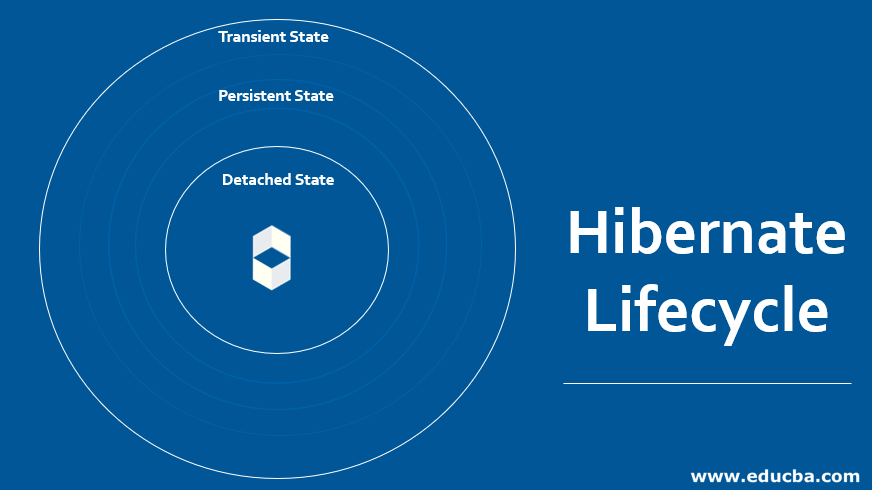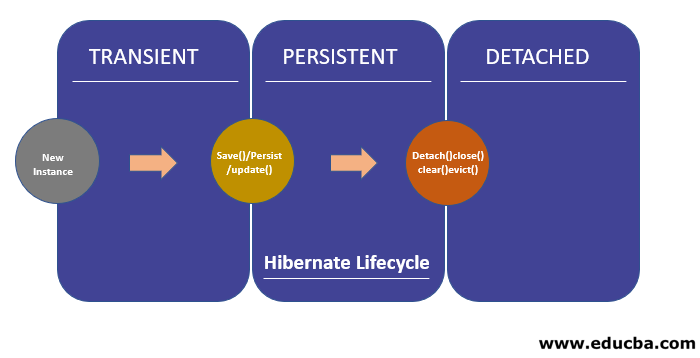Updated February 10, 2023

Introduction to Hibernate Lifecycle
Hibernate is an object-relational model to map the object-oriented JAVA programming language to the relational model database by handling the impedance mismatch by replacing the direct database model with object handling functions. Hibernate not only serves as a layer to remove the differences between traditional programming language JAVA and relational database but also it does provide a mechanism for session management. In hibernate we maintain the states of the objects throughout the object’s lifetime so that we ensure to maintain consistency of data on all platforms which includes database and front end application associated. These states in hibernate lifecycle are:
State of Hibernate Lifecycle
These states in the life-cycle of hibernate are explained in detail below.
Diagram:
The lifecycle of hibernate session can be divided into three states which are:
1. Transient State
- In this state, the data object is not in connection with the hibernate application. It is a standalone object not connected to the front end JAVA application and to hibernate as well.
- We cannot do any change to this object until it gets connected to the backend database server. This object if is present in the database then we can invoke it using the get () or load () function.
- In case we want to create a new entity and do some changes to it independently then we can create the entity out of the database and that entity will be called transient. This entity can be published in the database after creating the required connections.
- The data in this state is saved in heap memory as it is not yet connected to hibernate. Once a hibernate connection is established then this data is committed into the database.
Example:
StudentObject student= new Studentobject();
// This is where we are creating a new data entity but which is not yet connected to the database via hibernate. So it is in a transient date.
Student.Roll_number (25);
Student.name ("Meghna");
Student.class ("12th standard");2. Persistent State
- The newly created entity can be published into the database by creating a connection between the database and the front end via hibernate.
- Once we establish a session connection between hibernate and database then the object enters into the state called persistent state.
- We can achieve this using different functions like persist (), save(), saveOrUpdate(), Update().
- We can also change the object which is present in the database after creating this connection. Please be aware that all the changes we do will be saved in the database only if this connection is active.
- Hibernate ensures that all the real-time changes get stored in the database when this connection is present. Hereby object we mean row in the database.
Example:
Session. Save(student);
Session.merge(student);
Session.Update(student);
Session.persist(student);
Session.saveOrUpdate(student);
Session.lock(student);3. Detached State
- Detached objects will be present in the database as it is as they were last saved when the session was active.
- As we disconnect the session from then onwards the changes will not be saved in the database.
- All changes which we do without the connection being established will not be recorded and saved in the backend.
- Several functions like detach(), close(), clear(), evict() can be used to attain this state.
Example:
Session.close(student);
Session.detach(student);
Session.evict(student);
Session.detach(student);Tip: We can use a detached state when we want to do small changes to the existing database and save it in a different location for different use. This way we can have a similar dataset saved at different locations.
Important Points to Summarize
- Plain old JAVA Object (POJO) which is created newly will be in a transient state. The object in this state does not hold any place in the database in the form of a row. As the name suggests it will be plain JAVA object.
- The unique hibernate connection will be established when we have a persistent object created. This object will be denoted as a row in the database having an active connection with the frontend. Any changes made from the front end are saved in the database whenever commit() function is being called.
- Detached objects are the objects when the active session connection is revoked. Changes will not be recorded in the database until the connection is restored.
- There are some objects termed as “removed”. They are passed from the remove () function. They will be deleted from the database as soon as the delete function is committed to the database.
Conclusion
Hibernate objects have simple states in their lifecycle so as to maintain the consistency of data on all the objects, applications associated with the application. This feature of hibernate ensures that the data is not missed from being stored and thereby improves fault tolerance and provides scalable application in the wide era of JAVA applications on boom.
The hibernate sessions and their lifecycle is a simple technique to keep the database intact for a longer period of time. It provides enough resistance from the unwanted changes which are provided by states like detached and transient. For hibernating to work we need to make sure that JAVA objects are well annotated otherwise hibernate will not be able to recognize JAVA objects.
Recommended Articles
This is a guide to the Hibernate Lifecycle. Here we discuss the diagram, examples, and states which are included in the hibernate lifecycle with important points. You may also look at the following articles to learn more-


